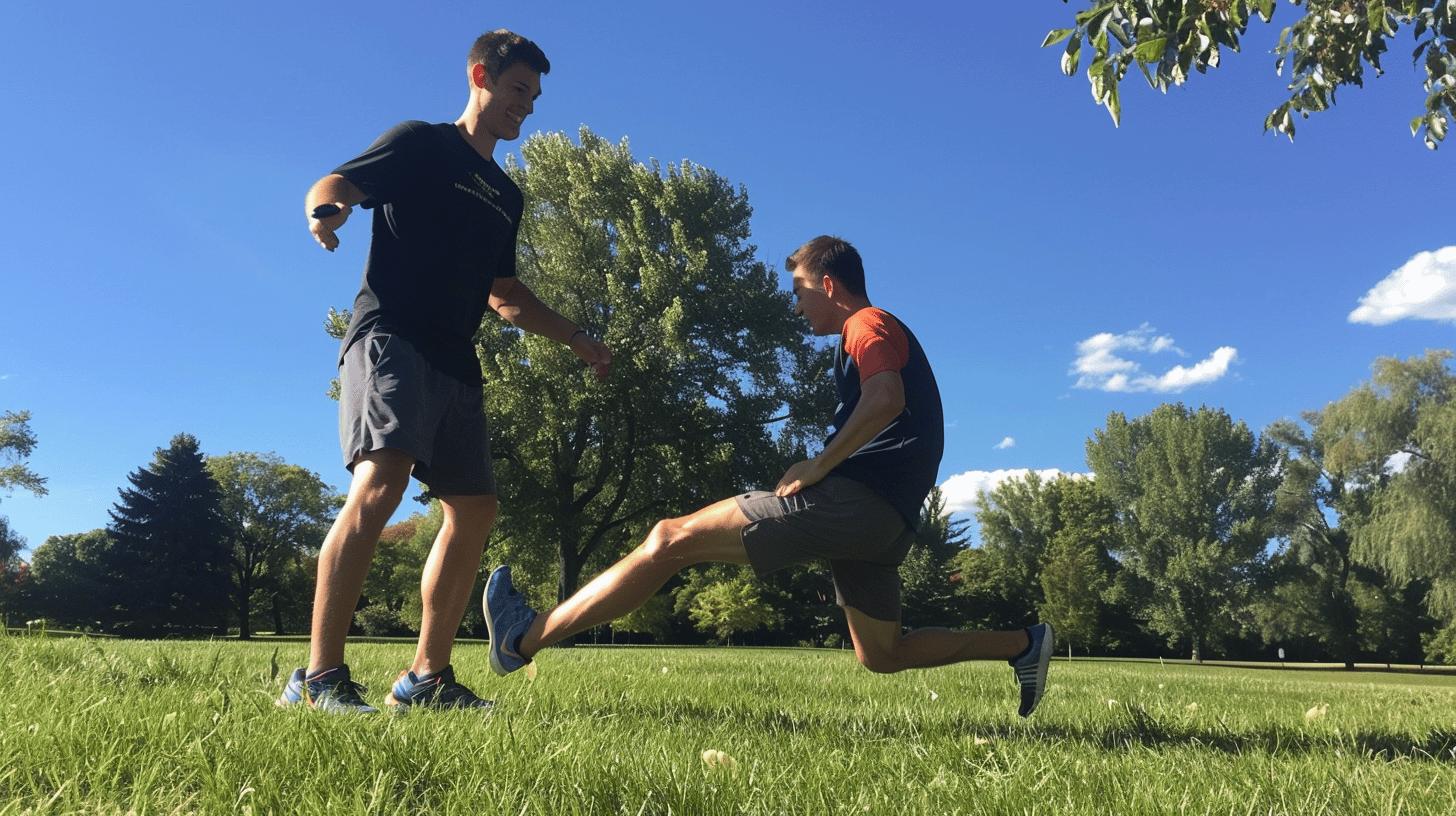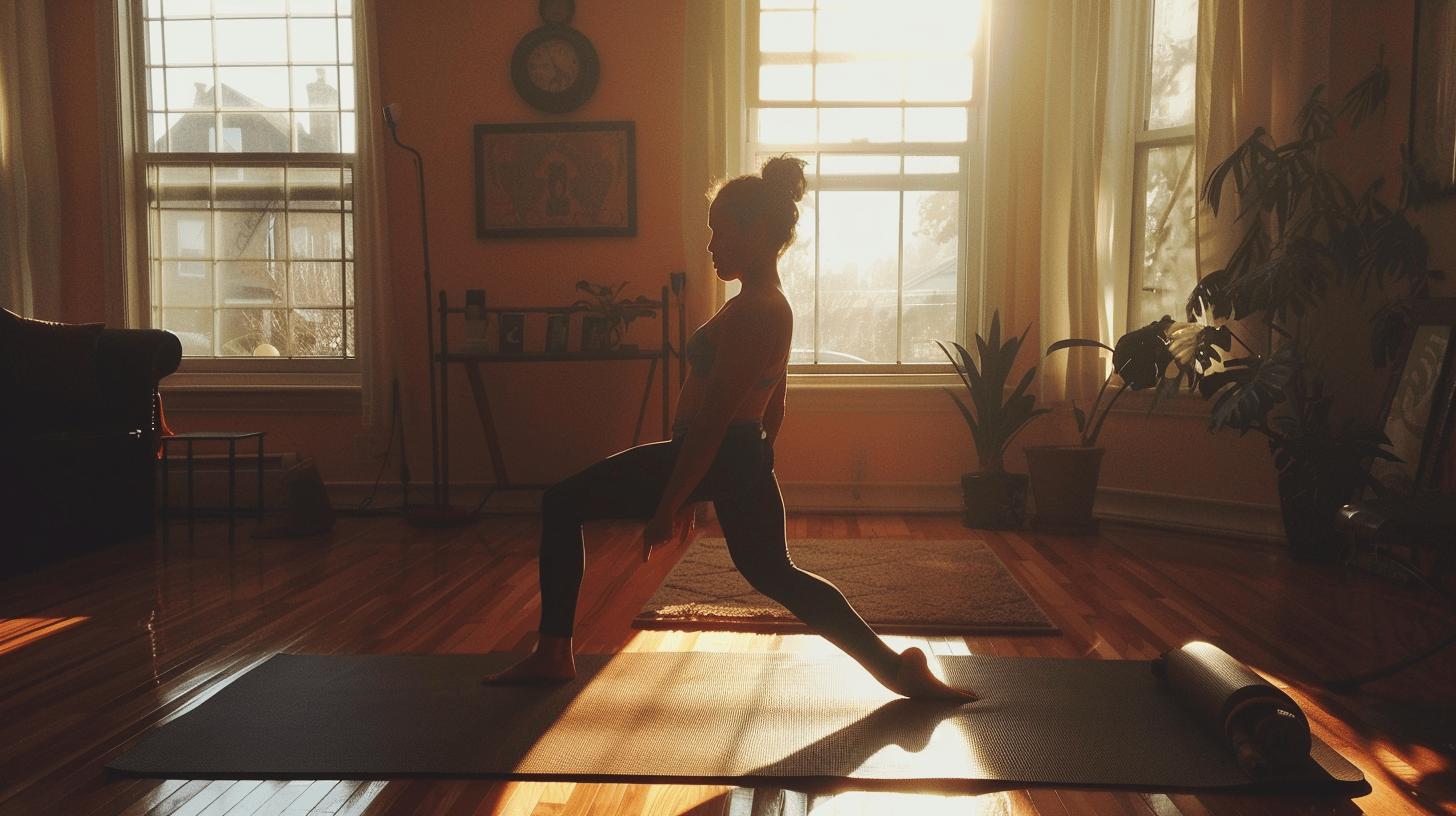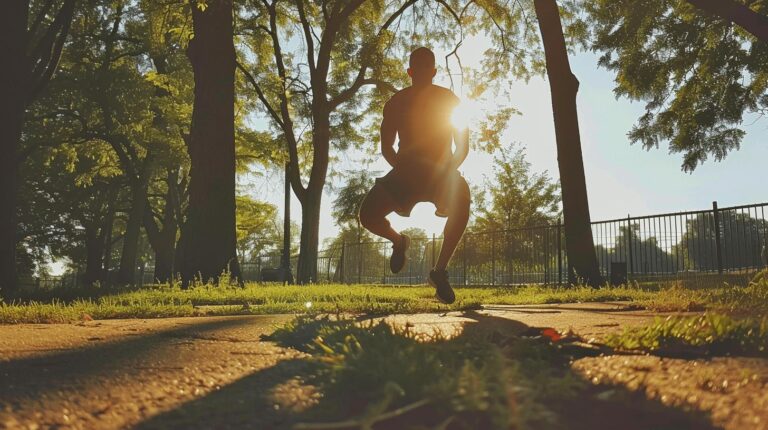Is knee pain slowing you down on your runs? If so, incorporating knee strengthening exercises might be your game-changer. Strong knees not only boost performance but also significantly reduce the risk of injuries. This article dives into the top effective exercises tailored for runners to fortify their knees. From wall sits to single-leg glute bridges, discover targeted routines that help enhance your running experience. Ready to run farther and faster with healthier knees? Let's break down the best exercises to get you there.
Best Knee Strengthening Exercises for Runners
Knee strengthening is crucial for runners to prevent injuries and enhance performance. Incorporating consistent exercises targeting key muscle groups like the quadriceps, hamstrings, glutes, hip flexors, and core can significantly improve knee stability and function. Performing these exercises 2-3 times per week with proper technique is essential for their effectiveness.
Each exercise targets specific muscles and provides unique benefits. The following list includes some of the most effective knee strengthening exercises for runners:
- Wall Sit: Engages quadriceps, glutes, and core. Enhances endurance and knee stability.
- Standing Hamstring Stretch: Targets hamstrings. Improves flexibility and reduces muscle tightness.
- Standing Quad Stretch: Focuses on quadriceps. Enhances flexibility and prevents muscle imbalances.
- Single Leg Glute Bridge: Strengthens glutes and hamstrings. Improves single-leg stability and pelvic alignment.
- Step-Up With Knee Drive: Activates quadriceps, hamstrings, and glutes. Enhances functional strength and balance.
- Sitting Leg Raises: Targets quadriceps. Strengthens knee extensors and improves joint stability.
- Single-Leg Box Step-Down: Engages quadriceps, hamstrings, and glutes. Enhances eccentric control and balance.
- Forward Lunge: Focuses on quadriceps, hamstrings, and glutes. Builds dynamic strength and stability.
- Lying Hamstring Curl With Dumbbell: Strengthens hamstrings. Improves knee flexion strength and muscle balance.
- Clamshells: Targets glutes and hip abductors. Enhances lateral stability and reduces knee strain.
Advanced Knee Strengthening Exercises for Runners
Advanced knee strengthening exercises are essential for experienced runners aiming to boost knee stability, control, and overall strength. These exercises often incorporate resistance bands, single-leg movements, and plyometric drills to provide comprehensive conditioning. Proper form is crucial to maximize benefits and prevent injuries.
Resistance Band Training
Resistance band training is effective for knee strengthening because it provides variable resistance throughout the exercise. This variability helps in targeting the stabilizing muscles around the knee, enhancing both strength and control.
Execution:
- Lateral Band Walks: Place a resistance band around your thighs, just above the knees. With a slight bend in your knees, step sideways in a controlled manner, maintaining tension in the band. Repeat for 15-20 steps in each direction.
- Band Squats: Position the band above your knees and perform squats. Focus on keeping your knees aligned with your toes throughout the movement to engage the glutes and quadriceps effectively.
Single-Leg Squats
Single-leg squats are paramount for developing unilateral strength and balance, reducing the risk of muscle imbalances which can lead to knee injuries.
Execution:
- Stand on one leg with the other leg extended forward. Slowly lower your body into a squat position by bending the knee of the standing leg. Keep your chest up and back straight. Return to the starting position. Aim for 3 sets of 10-12 reps per leg.
Targeted Muscles:
- Quadriceps
- Hamstrings
- Glutes
- Core
Plyometric Drills
Plyometric drills enhance explosive strength and knee stability, crucial for runners who need quick, powerful movements.
Execution:
- Jump Squats: Start in a squat position and explosively jump up, reaching your arms overhead. Land softly back into the squat position. Perform 3 sets of 8-10 reps.
- Box Jumps: Stand in front of a sturdy box or platform. Jump onto the box, landing softly with both feet. Step back down and repeat. Aim for 3 sets of 8-10 reps.
Benefits:
- Increased power
- Improved knee stability
- Enhanced coordination
Physiotherapy Exercises for Knee Pain in Runners

For runners dealing with knee pain, physiotherapy exercises can be an effective way to alleviate discomfort and improve knee function. These exercises target muscles and structures around the knee to enhance stability and strength. It is advisable to seek professional guidance from a physiotherapist, especially if pain persists or worsens.
Key Exercises
- Clamshells: This exercise targets the gluteus medius and hip abductors. Lie on your side with your knees bent at a 90-degree angle. Keeping your feet together, lift your top knee as high as possible without moving your pelvis. Lower it back down slowly. This helps to improve hip stability and reduce knee strain.
- Bridges: Bridges strengthen the glutes and hamstrings. Lie on your back with your knees bent and feet flat on the ground. Lift your hips towards the ceiling, squeezing your glutes at the top, then lower back down. This exercise helps improve pelvic alignment and knee stability.
- Leg Lifts: Leg lifts target the quadriceps and hip flexors. Lie on your back with one leg straight and the other bent. Lift the straight leg to the height of the bent knee, hold for a few seconds, then lower it slowly. This exercise strengthens the knee extensors and enhances joint stability.
- Calf Raises: Calf raises work the gastrocnemius and soleus muscles. Stand with your feet hip-width apart and slowly rise onto your toes, then lower back down. This exercise supports knee function by strengthening the muscles that control ankle and knee movements.
- Hamstring Curls: Hamstring curls focus on the hamstrings. Lie on your stomach with a resistance band around your ankles. Bend one knee to bring your heel towards your buttocks, then slowly return to the starting position. This exercise enhances knee flexion strength and muscle balance.
Exercise Benefit Clamshells Improves hip stability and reduces knee strain Bridges Enhances pelvic alignment and knee stability Leg Lifts Strengthens knee extensors and improves joint stability Calf Raises Supports knee function by strengthening ankle and knee muscles Hamstring Curls Enhances knee flexion strength and muscle balance
Preventing Knee Injuries: Tips for Runners
Preventing knee injuries is essential for runners to maintain performance and avoid downtime. Effective preventative measures encompass core strengthening, flexibility enhancement, proper footwear, and adhering to good running form. These strategies work together to create a balanced and resilient musculoskeletal system, reducing the likelihood of knee injuries.
Core strengthening routines are fundamental because a strong core stabilizes the entire body, including the knees. Flexibility drills improve the range of motion, making it easier for muscles and joints to absorb the impact of running. Using proper footwear provides the necessary support and cushioning, while practicing good running form distributes forces evenly, minimizing stress on the knees.
-
Core Strengthening Exercises: Planks, side planks, and bicycle crunches. Perform these exercises 3 times a week to stabilize the core.
-
Flexibility Drills: Dynamic stretches like leg swings and static stretches such as hamstring and quadriceps stretches. Incorporate these before and after runs.
-
Proper Footwear: Choose running shoes that fit well and provide adequate arch support. Replace them every 300-500 miles.
-
Running Form: Maintain an upright posture, keep your strides short, and land softly on your midfoot.
-
Ankle Mobility Exercises: Ankle circles and calf stretches. Perform these exercises daily to enhance mobility and support knee function.
-
Strength Training: Include squats, lunges, and deadlifts in your routine. Aim for 2-3 strength training sessions per week.
- Warm-Up and Cool-Down: Always start with a warm-up and finish with a cool-down to prepare your muscles for running and aid in recovery.
By integrating these strategies into your training regimen, you can significantly reduce the risk of knee injuries and maintain consistent running performance.
How to Strengthen Knee Ligaments and Tendons for Runners
Strengthening knee ligaments and tendons is crucial for runners to enhance knee stability and mitigate the risk of injuries. Key exercises that focus on isometric holds, balance, and proprioception can effectively fortify these vital structures.
-
Isometric Quad Contraction:
- Steps: Sit on the floor with your legs straight. Tighten the muscles on the front of your thigh (quadriceps) and hold for 5-10 seconds. Relax and repeat for 10-15 repetitions.
- Benefit: Strengthens the quadriceps without moving the knee joint, reducing stress on ligaments.
-
Single-Leg Balance:
- Steps: Stand on one leg with the other leg slightly lifted. Maintain your balance for 30 seconds to 1 minute. Switch legs and repeat. Perform 3 sets per leg.
- Benefit: Enhances proprioception and strengthens stabilizing muscles around the knee.
-
Heel Raises:
- **Steps**: Stand with your feet hip-width apart. Slowly raise your heels off the ground and hold for a few seconds, then lower back down. Aim for 3 sets of 15 repetitions.
- **Benefit**: Strengthens the calf muscles and supports the knee's tendons and ligaments.
-
Lateral Band Walks:
- Steps: Place a resistance band around your thighs, just above the knees. With a slight bend in your knees, step sideways for 15-20 steps in each direction, maintaining tension in the band.
- Benefit: Targets the hip abductors, which help stabilize the knee joint.
-
Proprioception Drills:
- Steps: Use a wobble board or balance cushion. Stand on the board with both feet and try to maintain your balance for 1-2 minutes. Progress to standing on one foot as your balance improves.
- Benefit: Improves knee stability by enhancing proprioceptive feedback and muscle coordination.
By incorporating these exercises into a regular training routine, runners can effectively strengthen their knee ligaments and tendons, leading to improved stability and a reduced risk of injury.
Knee Strengthening Exercises at Home Without Equipment

For runners, maintaining strong knees is essential for optimal performance and injury prevention. You don't need fancy equipment to achieve this; several effective knee strengthening exercises can be performed at home. These exercises primarily use body weight to enhance knee strength and stability, making them accessible and practical for anyone.
Bodyweight squats, lunges, step-ups, and glute bridges are among the most beneficial exercises. These movements target key muscle groups such as the quadriceps, hamstrings, glutes, and hip flexors. Incorporating these exercises into your routine 2-3 times a week can significantly improve knee function and reduce the risk of injuries.
- Bodyweight Squats: Stand with feet shoulder-width apart. Lower your body by bending your knees and hips, keeping your back straight. Return to the starting position. Perform 3 sets of 15 reps.
- Lunges: Stand upright, step one foot forward, and lower your body until both knees are at 90-degree angles. Push back to the starting position. Alternate legs for 3 sets of 12 reps per leg.
- Step-Ups: Find a step or sturdy surface. Step up with one foot, bringing the other foot to meet it, then step down. Alternate legs for 3 sets of 15 reps per leg.
- Glute Bridges: Lie on your back with knees bent and feet flat on the ground. Lift your hips towards the ceiling, squeezing your glutes at the top, then lower back down. Aim for 3 sets of 20 reps.
- Single-Leg Deadlifts: Stand on one leg, keeping the other leg slightly bent. Hinge at your hips to lower your torso forward while extending the free leg behind you. Return to the starting position. Perform 3 sets of 10 reps per leg.
- Calf Raises: Stand with feet hip-width apart. Raise your heels off the ground, then lower them back down. Perform 3 sets of 20 reps.
- Wall Sits: Lean against a wall with feet shoulder-width apart, then slide down until your knees are at a 90-degree angle. Hold this position for 30-60 seconds. Perform 3 sets.
These exercises, when performed consistently with proper form, can enhance knee stability and strength, supporting your running endeavors.
Knee Pain Relief Exercises for Runners
Runners frequently experience knee pain, which can hinder performance and lead to long-term injuries if not managed properly. Effective knee pain relief exercises encompass gentle stretches, low-impact aerobic exercises, and specific strengthening routines. These exercises aim to alleviate discomfort, improve knee function, and promote overall joint health.
Gentle stretches, such as hamstring stretches, help in maintaining flexibility and reducing muscle tightness around the knee. Low-impact aerobic exercises like walking or cycling can enhance blood flow and support joint lubrication, reducing pain. Strengthening routines, including calf raises and mini-squats, target key muscle groups to improve stability and support for the knee joint.
-
Hamstring Stretches: Stretching the hamstrings reduces tension on the knee. Sit on the ground with one leg extended and the other bent. Reach towards your toes, holding the position for 20-30 seconds. Repeat 3 times per leg.
-
Calf Raises: Strengthens the gastrocnemius and soleus muscles, supporting knee function. Stand with feet hip-width apart, rise onto your toes, hold for a few seconds, then lower back down. Aim for 3 sets of 15-20 reps.
-
Mini-Squats: Enhances knee stability by strengthening the quadriceps and glutes. Stand with feet shoulder-width apart, bend your knees slightly, and lower your body a few inches. Return to the starting position. Perform 3 sets of 10-15 reps.
-
Quadriceps Stretch: Improves flexibility and reduces strain on the knee. Stand on one leg, pulling the opposite foot towards your buttocks with your hand. Hold for 20-30 seconds and switch legs. Repeat 3 times per leg.
-
Side-Lying Leg Lifts: Targets the hip abductors and improves lateral stability. Lie on your side with legs straight. Lift the top leg towards the ceiling, hold for a few seconds, then lower it back down. Perform 3 sets of 12-15 reps per leg.
Final Words
In the action, this article outlined the best knee strengthening exercises for runners, including key exercises and advanced techniques like resistance band training and single-leg squats.
Physiotherapy exercises and preventative measures were also discussed to alleviate knee pain and prevent injuries.
Focusing on exercises for knee ligaments and tendons, and home workouts without equipment, highlighted the comprehensive approach needed for knee health.
Final thoughts on knee strengthening for runners underscore its importance in maintaining performance and reducing injury risk.
Ending on a positive note, consistent practice of these exercises will enhance knee strength and overall running efficiency.
FAQ
How do runners strengthen their knees?
Runners strengthen their knees through specific exercises such as wall sits, standing hamstring stretches, single leg glute bridges, step-ups with knee drive, and forward lunges. These exercises target key muscle groups including the quadriceps, hamstrings, and glutes.
What is the fastest way to fix runner's knee?
The fastest way to fix runner's knee involves a combination of rest, ice, compression, and elevation (RICE), along with physiotherapy exercises like clamshells, bridges, and leg lifts to improve knee function and alleviate pain.
Can weak knees be strengthened?
Yes, weak knees can be strengthened through consistent exercise routines that include bodyweight squats, lunges, glute bridges, and step-ups. These exercises help build strength and stability in the knees.
Can I still strength train with runner's knee?
Yes, you can still strength train with runner's knee by focusing on low-impact exercises and avoiding high-stress activities that worsen symptoms. Consult a physiotherapist for personalized guidance.
What are the best knee strengthening exercises for runners?
The best knee strengthening exercises for runners include wall sits, standing hamstring stretches, single leg glute bridges, sitting leg raises, single-leg box step-downs, and forward lunges. These exercises should be performed 2-3 times per week.
How to strengthen knee ligaments and tendons for runners?
Strengthen knee ligaments and tendons by performing isometric holds, balance exercises, and proprioception drills. These exercises enhance knee stability and reduce the risk of ligament injuries.
What are effective knee strengthening exercises at home?
Effective knee strengthening exercises at home without equipment include bodyweight squats, lunges, step-ups, glute bridges, and single-leg stands. These can be performed easily and improve knee strength and stability.
What physiotherapy exercises help with knee pain?
Physiotherapy exercises for knee pain include clamshells, bridges, leg lifts, and seated knee extensions. These exercises help alleviate pain and improve knee function.
Which exercises prevent knee injuries in runners?
Exercises that prevent knee injuries in runners include core strengthening routines like planks, flexibility drills like hamstring stretches, and ankle mobility exercises. Proper footwear and good running form also help prevent injuries.

